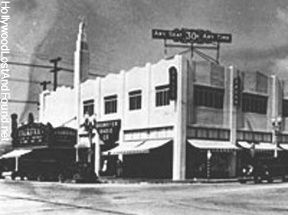I just noticed that the Laemmles have given up the Fairfax to a company called Regency, which have turned it into the Westside's most needed second bargain house, charging only $3 as compared the Vine on Hollywood Blvd.'s $7. In light of the public comments last year that
their main reason for decreasing theatrical attendance was the high cost of doing so, this theater in this location should be watched to see to what degree people are still willing to wait a month or two to see a film on the big screen at a lower price. Anecdotal evidence suggests that prior to 1980 more Americans saw movies subrun, i.e. in neighborhood or grind houses or at drive-ins than in their first run release. Because attendance figures have traditionally been founded on boxoffice figures, and most subrun situations were flat rentals, one set price, sometimes as low as $5 as late as the mid-Sixties, there is no accurate record of attendance at these theaters, but there
is evidence of their cultural influence in the number of films from the Fifties and Sixties which are part of our collective pop culture though they don't appear on any list of annual top grossing films.
Subrun exhibition was essentially ended by the increasing popularity of wide first run releases, which United Artists had first experimented with the New York area in the summer of 1956, followed by a wider, most successful experiment by that company and 20th Century-Fox in 1961. In it, rather than opening a film in one downtown theater, it would open concurrently in 25 or so neighborhood houses around the area. Though initially prices weren't raised that much and there were increased charges in getting prints to theaters, the approach sufficiently increased first run income as to become increasingly popular over the next 15 years. The ability to make prints faster from an internegative rather than off the original increased the number of areas in which this could be done concurrently, and the successful release of JAWS by this method in 1975 pretty much killed single situation first run engagements. Over the next five years many neighborhood houses would be turned into first run houses, or closed.
And this was before home video seriously impacted moviegoing.

The Fairfax, like the Gordon, Oriental, and Pan-Pacific, where neighborhood houses in the Hollywood area that go back at least to the Thirties (it can be seen in the background of the football field sequence in the 1935 Three Stooges short, THREE LITTLE PIGSKINS), all of which were reportedly successful in the Seventies and early Eighties, according to people who'd worked in them (not the reportedly late and unlamented Louis Federici). Much of the audience was composed of the twentysomethings who lived within walking distance of the theaters, plus there was usually adjacent free parking. This is no doubt what attracted Odious Cineplex into buying or leasing the Fairfax and Gordon in the mid-Eighties and, naturally, plexing the former and turning it into the Showcase (how the latter escaped plexing is probably one of their rare, but fortunate, lapses). The Oriental and Pan-Pacific were closed and torn down because the property owners wanted to put the land or buildings to other uses, the same fate that befell the infamous World Theater on Hollywood Blvd. in 1985; I was told at the time by someone in Robert W. Selig's office at Pacific Theaters that had they would
never have closed the theater as it was one of their most profitable; the last time I drove by the spot it was a hole in the ground.
However, the "upgrading" of the Fairfax and Showcase coincided with significant social changes in the neighborhood. The previous clientele of the theaters, who might have been receptive to the arthouse fare Odious Cineplex was putting in, if they could afford the usual annual price raises, were being priced out of the area and "Preferential Parking" zones were being granted to most of the streets surrounding them; I'm surprised that the Showcase manages to hang in with
absolutely no parking around it at any time, not even any lots! (The Vine on Hollywood Blvd. has a similar problem; it's in the heart of the nightclub area that has recently become popular, so not only is there no street parking anywhere near it, but the parking lots, and the one from SUNSET BOULEVARD is still there, cost more than admission to the theater.)
Though the side streets around the Fairfax have "Preferential Parking", some space can still be found after 6 on Beverly and on Fairfax, so there is a chance this theater can make it through with its bargain policy, attracting not the better heeled neighbors who have all the latest home theater gadgets, but the remaining 20-60 year olds who either can't afford these things or cannot fit them into their tiny apartments who would still like to see movies on the big screen but can't afford the Arclight or the Grove, especially on a regular basis. Less affluent people in outlying areas of L.A. still do this, but until now this option has been denied those who live closer to the center of the industry.
A study of the relative success of this theater, and also of the popularity of the various films, could actually be a greater guide to the future direction of theatrical production. As was pointed out last year, audiences stayed away from many films that had high expectations because
they didn't think they were worth $10-20. Are they worth $3 or should they have been sent straight to video, or not made at all?



















